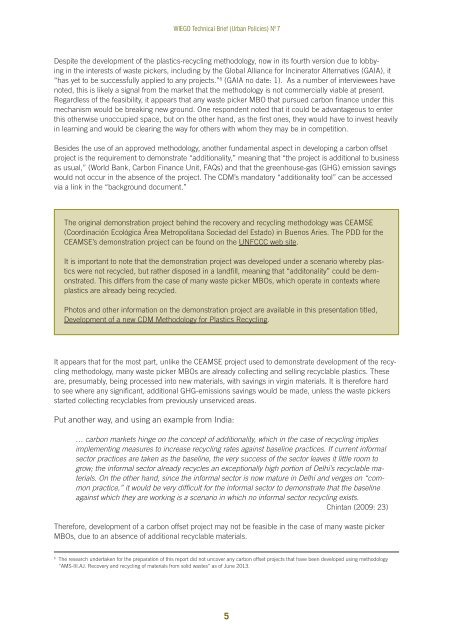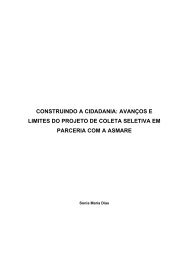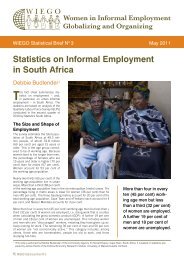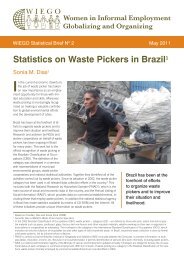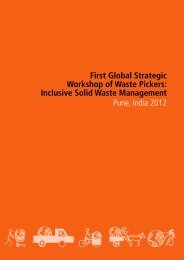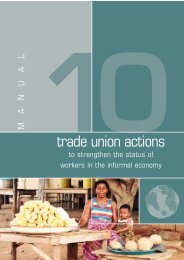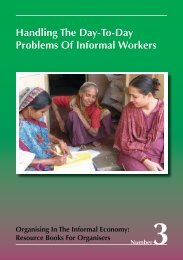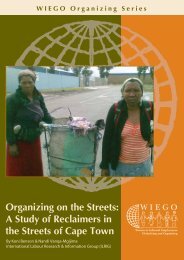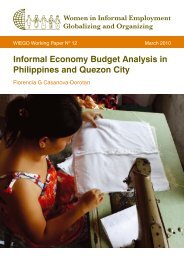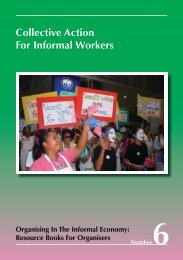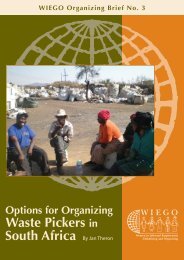Waste Pickers and Carbon Finance: Issues to Consider - WIEGO
Waste Pickers and Carbon Finance: Issues to Consider - WIEGO
Waste Pickers and Carbon Finance: Issues to Consider - WIEGO
- No tags were found...
Create successful ePaper yourself
Turn your PDF publications into a flip-book with our unique Google optimized e-Paper software.
<strong>WIEGO</strong> Technical Brief (Urban Policies) N o 7Despite the development of the plastics-recycling methodology, now in its fourth version due <strong>to</strong> lobbyingin the interests of waste pickers, including by the Global Alliance for Incinera<strong>to</strong>r Alternatives (GAIA), it“has yet <strong>to</strong> be successfully applied <strong>to</strong> any projects.” 6 (GAIA no date: 1). As a number of interviewees havenoted, this is likely a signal from the market that the methodology is not commercially viable at present.Regardless of the feasibility, it appears that any waste picker MBO that pursued carbon finance under thismechanism would be breaking new ground. One respondent noted that it could be advantageous <strong>to</strong> enterthis otherwise unoccupied space, but on the other h<strong>and</strong>, as the first ones, they would have <strong>to</strong> invest heavilyin learning <strong>and</strong> would be clearing the way for others with whom they may be in competition.Besides the use of an approved methodology, another fundamental aspect in developing a carbon offsetproject is the requirement <strong>to</strong> demonstrate “additionality,” meaning that “the project is additional <strong>to</strong> businessas usual,” (World Bank, <strong>Carbon</strong> <strong>Finance</strong> Unit, FAQs) <strong>and</strong> that the greenhouse-gas (GHG) emission savingswould not occur in the absence of the project. The CDM’s m<strong>and</strong>a<strong>to</strong>ry “additionality <strong>to</strong>ol” can be accessedvia a link in the “background document.”The original demonstration project behind the recovery <strong>and</strong> recycling methodology was CEAMSE(Coordinación Ecológica Área Metropolitana Sociedad del Estado) in Buenos Aries. The PDD for theCEAMSE’s demonstration project can be found on the UNFCCC web site.It is important <strong>to</strong> note that the demonstration project was developed under a scenario whereby plasticswere not recycled, but rather disposed in a l<strong>and</strong>fill, meaning that “addi<strong>to</strong>nality” could be demonstrated.This differs from the case of many waste picker MBOs, which operate in contexts whereplastics are already being recycled.Pho<strong>to</strong>s <strong>and</strong> other information on the demonstration project are available in this presentation titled,Development of a new CDM Methodology for Plastics Recycling.It appears that for the most part, unlike the CEAMSE project used <strong>to</strong> demonstrate development of the recyclingmethodology, many waste picker MBOs are already collecting <strong>and</strong> selling recyclable plastics. Theseare, presumably, being processed in<strong>to</strong> new materials, with savings in virgin materials. It is therefore hard<strong>to</strong> see where any significant, additional GHG-emissions savings would be made, unless the waste pickersstarted collecting recyclables from previously unserviced areas.Put another way, <strong>and</strong> using an example from India:… carbon markets hinge on the concept of additionality, which in the case of recycling impliesimplementing measures <strong>to</strong> increase recycling rates against baseline practices. If current informalsec<strong>to</strong>r practices are taken as the baseline, the very success of the sec<strong>to</strong>r leaves it little room <strong>to</strong>grow; the informal sec<strong>to</strong>r already recycles an exceptionally high portion of Delhi’s recyclable materials.On the other h<strong>and</strong>, since the informal sec<strong>to</strong>r is now mature in Delhi <strong>and</strong> verges on “commonpractice,” it would be very difficult for the informal sec<strong>to</strong>r <strong>to</strong> demonstrate that the baselineagainst which they are working is a scenario in which no informal sec<strong>to</strong>r recycling exists.Chintan (2009: 23)Therefore, development of a carbon offset project may not be feasible in the case of many waste pickerMBOs, due <strong>to</strong> an absence of additional recyclable materials.6The research undertaken for the preparation of this report did not uncover any carbon offset projects that have been developed using methodology“AMS-III.AJ. Recovery <strong>and</strong> recycling of materials from solid wastes” as of June 2013.5


